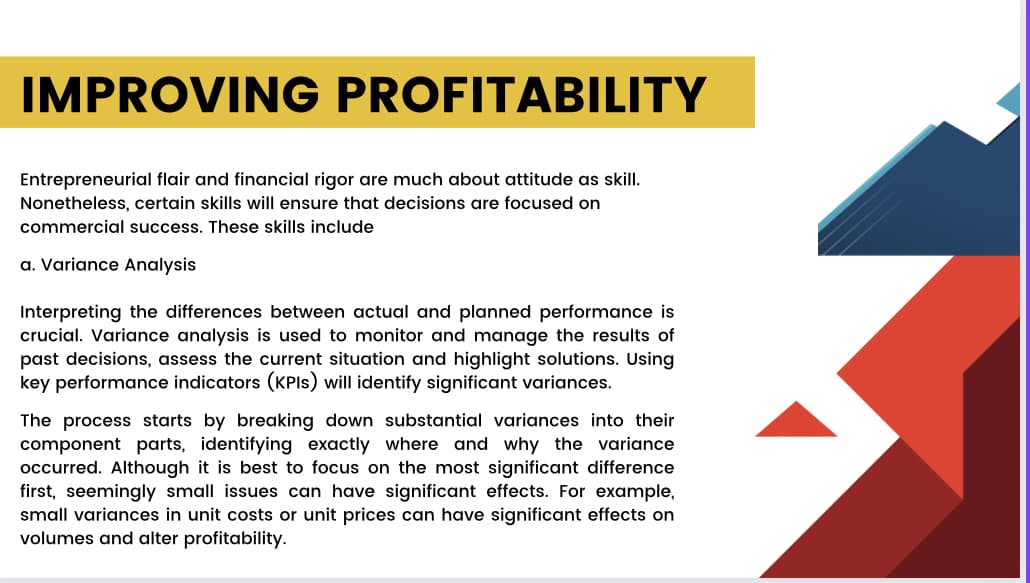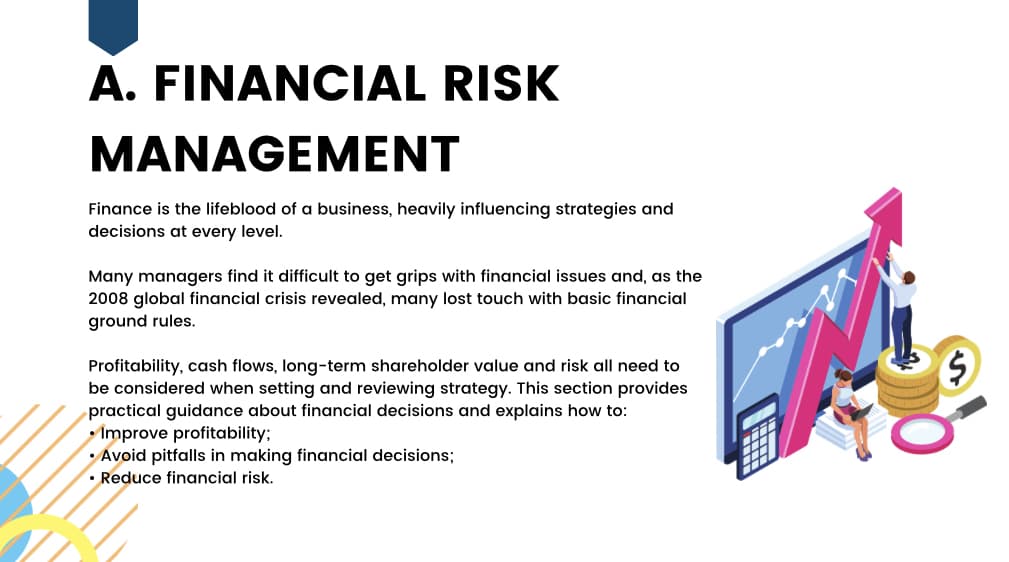IMPROVING PROFITABILITY Entrepreneurial flair and financial rigor are much about attitude as skill. Nonetheless, certain skills will ensure that decisions are focused on commercial success. These skills include a. Variance Analysis Interpreting the differences between actual and planned performance is crucial. Variance analysis is used to monitor and manage the results of past decisions, assess the current situation and highlight solutions. Using key performance indicators (KPIs) will identify significant variances. The process starts by breaking down substantial variances into their component parts, identifying exactly where and why the variance occurred. Although it is best to focus on the most significant difference first, seemingly small issues can have significant effects. For example, small variances in unit costs or unit prices can have significant effects on volumes and alter profitability.
IMPROVING PROFITABILITY Entrepreneurial flair and financial rigor are much about attitude as skill. Nonetheless, certain skills will ensure that decisions are focused on commercial success. These skills include a. Variance Analysis Interpreting the differences between actual and planned performance is crucial. Variance analysis is used to monitor and manage the results of past decisions, assess the current situation and highlight solutions. Using key performance indicators (KPIs) will identify significant variances. The process starts by breaking down substantial variances into their component parts, identifying exactly where and why the variance occurred. Although it is best to focus on the most significant difference first, seemingly small issues can have significant effects. For example, small variances in unit costs or unit prices can have significant effects on volumes and alter profitability.
Financial Reporting, Financial Statement Analysis and Valuation
8th Edition
ISBN:9781285190907
Author:James M. Wahlen, Stephen P. Baginski, Mark Bradshaw
Publisher:James M. Wahlen, Stephen P. Baginski, Mark Bradshaw
Chapter10: Forecasting Financial Statement
Section: Chapter Questions
Problem 2QE: The chapter encourages analysts to develop forecasts that are realistic, objective, and unbiased....
Related questions
Question
100%
Please explain the photo attached

Transcribed Image Text:IMPROVING PROFITABILITY
Entrepreneurial flair and financial rigor are much about attitude as skill.
Nonetheless, certain skills will ensure that decisions are focused on
commercial success. These skills include
a. Variance Analysis
Interpreting the differences between actual and planned performance is
crucial. Variance analysis is used to monitor and manage the results of
past decisions, assess the current situation and highlight solutions. Using
key performance indicators (KPIs) will identify significant variances.
The process starts by breaking down substantial variances into their
component parts, identifying exactly where and why the variance
occurred. Although it is best to focus on the most significant difference
first, seemingly small issues can have significant effects. For example,
small variances in unit costs or unit prices can have significant effects on
volumes and alter profitability.

Transcribed Image Text:A. FINANCIAL RISK
MANAGEMENT
Finance is the lifeblood of a business, heavily influencing strategies and
decisions at every level.
Many managers find it difficult to get grips with financial issues and, as the
2008 global financial crisis revealed, many lost touch with basic financial
ground rules.
Profitability, cash flows, long-term shareholder value and risk all need to
be considered when setting and reviewing strategy. This section provides
practical guidance about financial decisions and explains how to:
• Improve profitability;
• Avoid pitfalls in making financial decisions;
•Reduce financial risk.
$
Expert Solution
This question has been solved!
Explore an expertly crafted, step-by-step solution for a thorough understanding of key concepts.
This is a popular solution!
Trending now
This is a popular solution!
Step by step
Solved in 3 steps

Recommended textbooks for you

Financial Reporting, Financial Statement Analysis…
Finance
ISBN:
9781285190907
Author:
James M. Wahlen, Stephen P. Baginski, Mark Bradshaw
Publisher:
Cengage Learning

Principles of Accounting Volume 1
Accounting
ISBN:
9781947172685
Author:
OpenStax
Publisher:
OpenStax College

Business/Professional Ethics Directors/Executives…
Accounting
ISBN:
9781337485913
Author:
BROOKS
Publisher:
Cengage

Financial Reporting, Financial Statement Analysis…
Finance
ISBN:
9781285190907
Author:
James M. Wahlen, Stephen P. Baginski, Mark Bradshaw
Publisher:
Cengage Learning

Principles of Accounting Volume 1
Accounting
ISBN:
9781947172685
Author:
OpenStax
Publisher:
OpenStax College

Business/Professional Ethics Directors/Executives…
Accounting
ISBN:
9781337485913
Author:
BROOKS
Publisher:
Cengage